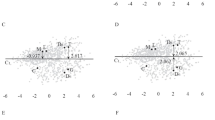Abstract
Although tetrachoric correlations provide a theoretically well-founded basis for the investigation of binary data by means of confirmatory factor analysis according to the congeneric model, the outcome does not always meet the expectations. As expected from analyzing the procedure of computing tetrachoric correlations, the data must show a high quality for achieving good results. In a simulations study it was demonstrated that such a quality could be established by a very large sample size. Robust maximum likelihood estimation improved model-data fit but not the appropriateness of factor loadings. In contrast, probability-based covariances and probability-based correlations as input to confirmatory factor analysis yielded a good model-data fit in all sample sizes. Probability-based covariances in combination with the weighted congeneric model additionally performed best concerning the absence of dependency on item marginals in factor loadings whereas probability-based correlations did not. The results demonstrated that it is possible to find a link function that enables the use of probability-based covariances for the investigation of binary data.
Access this chapter
Tax calculation will be finalised at checkout
Purchases are for personal use only
Similar content being viewed by others
References
Bryant FB, Satorra A (2012) Principles and practice of scaled difference chi-square testing. Struct Equ Model 19:373–398
Divgi DR (1979) Calculation of the tetrachoric correlation coefficient. Psychometrika 44:169–172
Fan W, Hancock GR (2012) Robust means modeling: an alternative for hypothesis testing of independent means under variance heterogeneity and nonnormality. J Educ Behav Stat 37:137–156
Genest C, Lévesque J-M (2009) Estimating correlation from dichotomized normal variables. J Stat Plan Inference 139:3785–3794
Hu L, Bentler PM (1999) Cutoff criteria for fit indexes in covariance structure analysis: conventional criteria versus new alternatives. Struct Equ Model 6:1–55
Jöreskog KG (1970) A general method for analysis of covariance structure. Biometrika 57: 239–257
Jöreskog KG (1971) Statistical analysis of sets of congeneric tests. Psychometrika 36:109–133
Jöreskog KG, Sörbom D (2001) Interactive LISREL: user’s guide. Scientific Software International Inc., Lincolnwood
Jöreskog KG, Sörbom D (2006) LISREL 8.80. Scientific Software International Inc., Lincolnwood
Kline RB (2005) Principles and practice of structural equation modeling, 2nd edn. Guliford, New York
Kubinger KD (2003) On artificial results due to using factor analysis for dichotomous variables. Psychol Sci 45:106–110
McCullagh P, Nelder JA (1985) Generalized linear models. Chapman and Hall, London
Muthén B (1984) A general structural equation model with dichotomous, ordered categorical, and continuous variable indicators. Psychometrika 49:115–132
Muthén B (1993) Goodness of fit with categorical and other nonnormal variables. In: Bollen KA, Long JS (eds) Testing structural equation models. Sage, Newbury Park, Thousand Oaks, pp 205–234
Nelder JA, Wedderburn RWM (1972) Generalized linear models. J R Stat Soc Ser A 135:370–384
Ogasawara H (2010) Accurate distribution and its asymptotic expansion for the tetrachoric correlation coefficient. J Multivar Anal 101:936–948
Owen DB (1956) Tables for computing bivariate normal probabilities. Ann Math Stat 27: 1075–1090
Pearson K (1900) Mathematical contributions to the theory of evolution. VII. On the correlation of characters not quantitatively measurable. Philos Trans R Soc Lond 195:1–47
Satorra A, Bentler PM (1994) Corrections to the test statistics and standard errors on covariance structure analysis. In: von Eye A, Glogg CC (eds) Latent variable analysis. Sage, Thousand Oaks, pp 399–419
Schweizer K (2013) A threshold-free approach to the study of the structure of binary data. Int J Stat Probab 2:67–75
Tallis GM (1962) The maximum likelihood estimation of correlation from contingency tables. Biometrics 18:342–353
Torgerson WS (1958) Theory and method of scaling. Wiley, New York
West SG, Finch JF, Curran PJ (1995) Structural equation models with nonnormal variables: problems and remedies. In: Hoyle RH (ed) Structural equation modeling: concepts, issues, and applications. Sage, Thousand Oaks, pp 56–75
Author information
Authors and Affiliations
Corresponding author
Editor information
Editors and Affiliations
Rights and permissions
Copyright information
© 2015 Springer International Publishing Switzerland
About this paper
Cite this paper
Schweizer, K., Ren, X., Wang, T. (2015). A Comparison of Confirmatory Factor Analysis of Binary Data on the Basis of Tetrachoric Correlations and of Probability-Based Covariances: A Simulation Study. In: Millsap, R., Bolt, D., van der Ark, L., Wang, WC. (eds) Quantitative Psychology Research. Springer Proceedings in Mathematics & Statistics, vol 89. Springer, Cham. https://doi.org/10.1007/978-3-319-07503-7_17
Download citation
DOI: https://doi.org/10.1007/978-3-319-07503-7_17
Publisher Name: Springer, Cham
Print ISBN: 978-3-319-07502-0
Online ISBN: 978-3-319-07503-7
eBook Packages: Mathematics and StatisticsMathematics and Statistics (R0)




